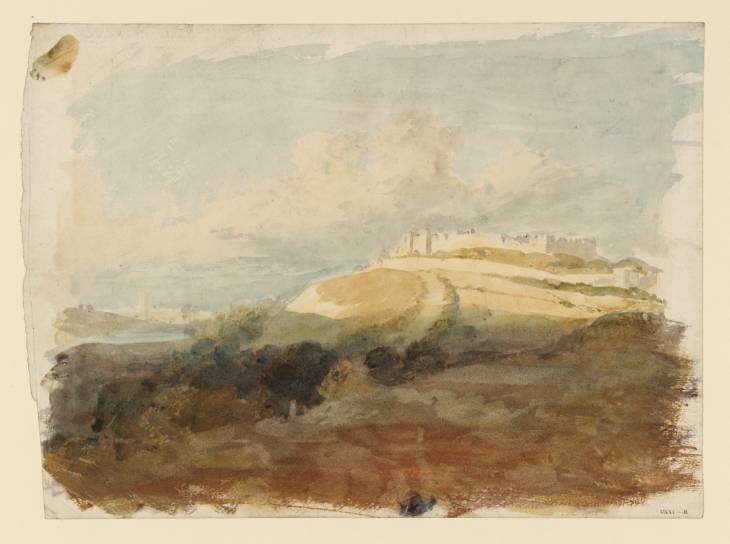Joseph Mallord William Turner Carisbrooke Castle c.1807-19
Joseph Mallord William Turner,
Carisbrooke Castle
c.1807-19
Joseph Mallord William Turner 1775–1851
Carisbrooke Castle circa 1807–19
D08274
Turner Bequest CXXI R
Turner Bequest CXXI R
Pencil and watercolour white wove lightweight writing paper, 231 x 319 mm
Watermark ‘J Whatman | 1807’
Blind-stamped with Turner Bequest monogram bottom right
Stamped in black ‘CXXI – R’ bottom right
Watermark ‘J Whatman | 1807’
Blind-stamped with Turner Bequest monogram bottom right
Stamped in black ‘CXXI – R’ bottom right
Accepted by the nation as part of the Turner Bequest 1856
Exhibition history
1904
National Gallery, London, various dates to at least 1904 (781).
References
1904
E.T. Cook and Alexander Wedderburn eds., Library Edition: The Works of John Ruskin: Volume XIII: Turner: The Harbours of England; Catalogues and Notes, London 1904, p.641 no.781, as ‘Carisbrook Castle (early)’.
1909
A.J. Finberg, A Complete Inventory of the Drawings of the Turner Bequest, London 1909, vol.I, p.334, CXXI R, as ‘Carisbrook Castle’, circa 1802–10.
1979
James S. Dearden, Turner’s Isle of Wight Sketchbook, Brighstone 1979, p.[10], pl.4.
As Finberg and Dearden have noted, this colour study is based on a watercolour and pencil view on a similar scale in the Isle of Wight sketchbook of 1795 (Tate D00432; Turner Bequest XXIV 25). The present work is less detailed, concentrating on and intensifying the contrast between the shadowy foreground and the sunlit castle and hilltop, seen to the north-west in evening light.
There are other views of Carisbrooke in the Isle of Wight sketchbook (Tate D00431, D00433, D00452; Turner Bequest XXIV 24, 25a, 44), a separate view of about 1796 (Tate D00881; Turner Bequest XXXIII J) and studies from the 1820s (Tate D20212–D20214, D20316; Turner Bequest CCXX F, G, H; CCXXIV 26) preceding the finished watercolour of about 1828 (Carisbrooke Castle Museum),1 engraved for Turner’s Picturesque Views in England and Wales.
Of the sheets known to have originated in the Studies for Liber sketchbook, this is the only one worked in full colour, as opposed to the characteristic ‘sepia’ brown of the Liber Studiorum compositions otherwise removed from it. There is no watercolour evident on the stub remaining in the book (see technical notes below), whereas the washes at the left of this truncated sheet reach right to the edge, suggesting that they were applied at least in part after this leaf was torn from the book.
In the absence of specific evidence, the span of the Liber Studiorum’s active publication and hence Turner’s likely use of the Studies for Liber sketchbook, 1807–19, is suggested here as a range for the present work (as it is for various unpublished Liber designs), whether or not there is a Liber connection. It may be that there is none, and Turner just needed a sheet of this size for another purpose, in which case its function may be as a ‘colour beginning’ of the type common between the 1810s and the 1830s in relation to projects such as England and Wales (of which there are many examples at Tate; see particularly Turner Bequest grouping CCLXIII).
If the watercolour was begun as a potential Liber subject it was clearly rejected, but it might be suggested that there are aspects of the composition fortuitously or deliberately comparable and contrastable with those of Dunstanborough Castle, engraved in 1808 (for the watercolour design, see Tate D08118; Turner Bequest CXVI Q): sunlit castles on skylines with foregrounds deep in shade; Dunstanburgh – a ruin – at dawn on the coast, massed towards the left; Carisbrooke – relatively intact but still picturesque – towards sunset inland, massed towards the right.
Technical notes:
Catalogued by Finberg in a grouping of colour studies,1 the sheet has been identified by Peter Bower as ‘probably’ originating in the Studies for Liber sketchbook (Tate; Turner Bequest CXV),2 some leaves of which bear the same watermark. In fact, it can conclusively be shown to belong to the book, since the jagged left-hand edge here matches perfectly with the wide, torn stub, up to 73 mm across, immediately following folio 35 (the recto of which is Tate D40379; Turner Bequest CXV 44).
The separation was facilitated by scoring a freehand line from top to bottom of the leaf to the left of the watercolour, and then tearing it out; however, the scoring was rather ineffective, as the tear only follows it cleanly towards the bottom edge. The watercolour would form the verso if reunited with the sketchbook, suggesting that Turner originally worked inwards from both ends; a brown watercolour study for the unpublished Liber Studiorum subject Ploughing, Eton (Tate CXV 47; Turner Bequest D08100) is a similar instance, matching another stub at the back of the book as now foliated.
The colour is built up in washes with some stopping out or lifting within the darker tones in the foreground, where finger prints are also evident. Light pencil marks inside the left and right edges may have been rough guides for mounting for early display at the National Gallery; there are signs of darkening within the exposed area.
Verso:
Stuck down all round on an old British Museum mount; presumed blank.
Matthew Imms
August 2009
How to cite
Matthew Imms, ‘Carisbrooke Castle c.1807–19 by Joseph Mallord William Turner’, catalogue entry, August 2009, in David Blayney Brown (ed.), J.M.W. Turner: Sketchbooks, Drawings and Watercolours, Tate Research Publication, December 2012, https://www

